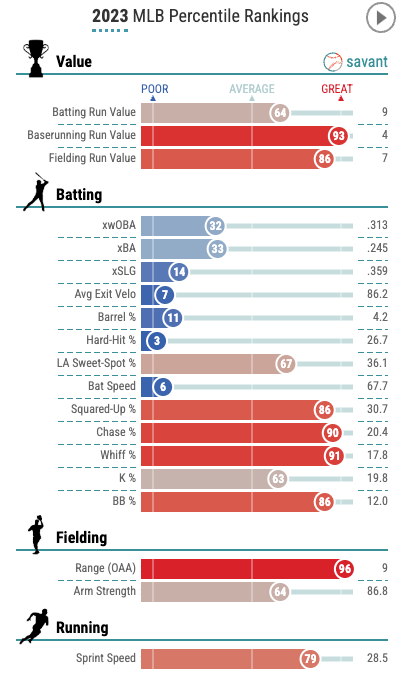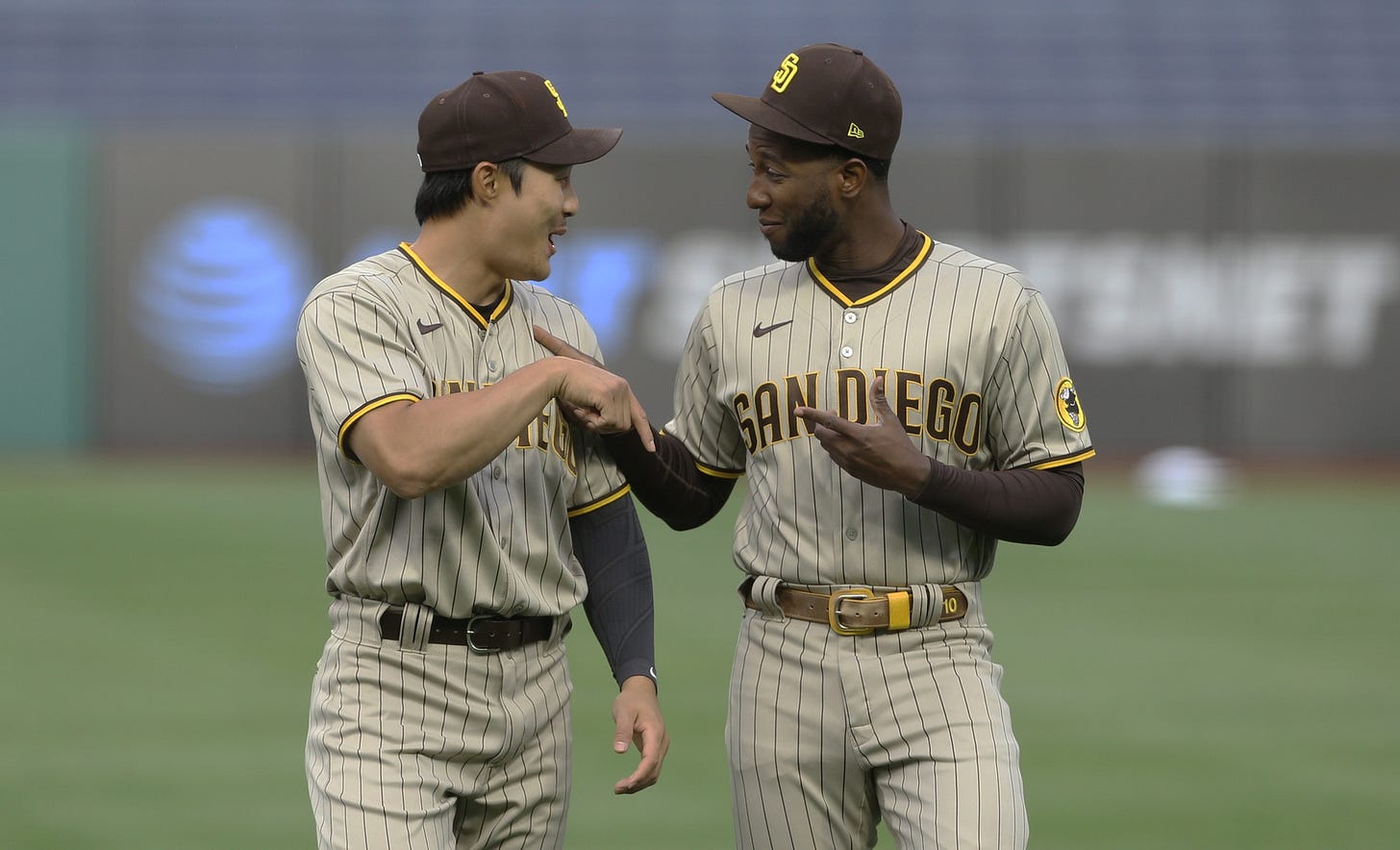The Atlanta Braves May Have Just Solved Shortstop for 2026
Claiming Ha-Seong Kim gives Atlanta a quality option for 2026 IF he picks up his player option
When he spoke to the media after the Atlanta Braves had a very quiet trade deadline, President of Baseball Operations Alex Anthopoulos told us that the front office viewed it as the beginning of Atlanta’s offseason.
He wasn’t kidding.
Since the trade deadline, Atlanta’s added several players that you could see contributing in 2026: reliever Tyler Kinley, outfielder Jake Fraley, and pitcher Hunter Stratton. They added the biggest one of all on Monday, claiming former San Diego Padres and Tampa Bay Rays shortstop Ha-Seong Kim on waivers. And he might end up being the starter in 2026.
Let’s talk about it.
Why is this a big deal?
Because when he’s been healthy, Kim has been one of the better shortstops in baseball.
Debuting with San Diego in 2021, he took a full-time role in 2022 and across the next two seasons, he hit .256/.338/.391 with 28 home runs and 50 stolen bases. Playing both shortstop and second base, with a little third base as required with the health of Manny Machado, he won the 2023 NL Utility Gold Glove after a 93rd percentile +4 Fielding Run Value.1
He was made the full-time shortstop over Xander Bogaerts for the 2024 season and put up a +4 OAA mark, although his bat slipped a bit as he hit .233 with a .700 OPS prior to needing season-ending shoulder surgery.
We’ve talked numerous times before about how it’s virtually impossible to find a decent shortstop in free agency and when one comes available, it’s usually an onerous contract. Atlanta got one seemingly for free.
Which begs the question: If he’s so good…
Why was Kim put on waivers?
Money. The notoriously frugal Tampa Bay Rays wanted to clear some payroll and this is how they chose to do it.
Kim’s holding a $16M player option for 2026 - by the fifth day after the World Series concludes, he needs to either accept his option and play for that amount in 2026 or he becomes a free agent.
And with their recent promotion of one of the best defensive shortstops in the minors, Carson Williams, combined with budding superstar Junior Caminero at third base, Tampa decided they didn’t want to potentially be on the hook for $16M for a second baseman.
Tampa Bay’s shedding of guaranteed money for 2026 has gotten extreme. With 2B Brandon Lowe, pitcher Pete Fairbanks, and utilityman Taylor Walls all likely gettig their club options declined, the Rays have just $19.75M in guaranteed on the 2026 roster. First baseman Yandy Diaz has $12M owed for his last guaranteed season and releiver Drew Rasmussen is getting $5.75M. They also have five already very affordable in arbitration and seven more first-time arb eligibles, while everyone else is making league minimum in their pre-arb years. FanGraphs projects a 2026 payroll of just $51M, as of now, pending arbitration awards.
It’s really as simple as that. Atlanta would have potentially entertained a trade with Tampa Bay this winter for the shortstop, but instead, they get him for taking the remaining ~$2M of his 2025 salary and the 2026 contract risk.
Wait, there’s risk here?
There absolutely is risk here, yes, and it’s because of the player option.
Atlanta doesn’t give them out for a reason - they would rather be able to make the decision on a player rather than being stuck with an underperforming asset. And know that there is a risk that Kim doesn’t return to the productive player he was with San Diego.
In his best seasons, Kim was a good defender and baserunner who, while not hitting for a lot of power, could run into 10-15 homers while providing at least an acceptable batting average with very little chase or whiffs and a good walk rate.
(I colloquially and complimentarily call this the “KBO profile” - fundamentally sound hitters with below-average power but good walk rates and defense)
Here’s a statcast card from his 2023 season:
There’s a lot of blue there, mostly around the power production numbers, but also a high-floor based on contact, a lack of chase, and a willingness to work a walk.
But because of the recovery from 2024’s shoulder surgery, one that delayed his Rays debut until early July, combined with hamstring, calf, and back injuries this season, he’s played just 24 games with a .214/.290/.321 line. He’s actually currently on the injured list with lower back inflammation, although he’s expected to be activated in the next few days.
Ozzie Albies’ down 2024 after last year’s wrist injury has shown us how injuries can impact a player’s production long after they’re returned to the field.
But no matter how well Kim performs down the stretch, he holds the power here. If he’s merely okay in September for Atlanta, he likely picks up the $16M player option for 2026 and looks to build a “platform” year before re-entering free agency at the age of 30. If he’s great, he might gamble on finding a long-term deal this winter, hoping to slip into a barren shortstop market behind presumed bag receiver Bo Bichette as the 2nd-best option.
But if he’s terrible, or gets injured again, he could opt in for 2026 and Atlanta’s on the hook for the $16M even if he never suits up for the franchise. There’s your risk.2
What if Atlanta just extends him?
I’m sure Anthopoulos is already planning on attempting that; the Braves extended Chris Sale just weeks after trading for him from the Boston Red Sox in December of 2023. Renegotiating his existing Boston contract allowed them to not only wipe out his deferred money, something Atlanta has no interest in putting on their books, but also guaranteed his 2025 option year as a way of sticking a 2026 club option on the back end of the deal.
But there are two big differences between Sale and Kim‘s contract situations: Kim’s option is a player option, not a club option, and his agent is Scott Boras.
As I mentioned earlier, Kim holds the power; no extension offer is likely to secure Atlanta a discount on the 2026 player option salary of $16M, unless a long-term deal is reached.
However, the more significant aspect here is the presence of Boras in the negotiations. It’s not the first time that AA’s Braves have dealt with Boras - they paid free agent starter Dallas Keuchel $13M for the remainder of the 2019 season after signing him in early June - but Boras’s style of business and AA’s style of business historically haven’t had a lot of common ground. Boras-negotiated contracts are typically full of player-friendly provisions, including player options and/or opt-outs, no-trade clauses, and substantial annual salary figures.
Third baseman Alex Bregman’s three-year pact with the Boston Red Sox, which was negotiated by Boras, is a perfect example of everything Atlanta does not want in their deals. Announced as three years and $120M, he’s receiving $25M per year in salary, got a signing bonus when the contract was executed, has an opt-out after 2025 and a player option for 2027, and is receiving ten years of deferred money at a rate of $6M a year from 2035-2044.
Atlanta, by contrast, doesn’t give out no-trade clauses, player (or mutual) options, or deferred money. They typically restrict the AAV to $22M a year (Bregman’s, after deferrals, is valued at $31.7M) and usually stick a club option on the back of the deal to give themselves an extra year to either negotiate an extension or figure out a succession plan.
I’m not saying it’s completely out of the realm of possibility that Kim signs an extension - ‘the agent works for the player’ and all - but it’s not likely to happen before the end of the season. Atlanta does have the ability to exclusively negotiate an extension with him after the season ends; his option decision is required by 5PM on the fifth day after the World Series, but Atlanta can negotiate with him at any time prior to that date.
They’ll ultimately have a month to evaluate what they want to do before needing to make a decision, again, all predicated on what Kim decides to do with his 2026 club option. Worst-case scenario, they’re paying $16M for a negative asset in 2026. Best-case scenario, he enjoys the clubhouse and organization so much down the stretch that he signs a multi-year deal to stick around and play with his best friend in San Diego, Jurickson Profar.
And the most likely scenario is that he gives Atlanta a higher floor at shortstop next season while they work on getting one of their recent collegiate draft picks at shortstop, Alex Lodise or Cody Miller, ready to make their debut at some point in 2027. And if Kim leaves after the 2026 season, Atlanta can extend him a qualifying offer and get an additional draft pick if he signs elsewhere.
The breakdown there was +3 OAA at third, +7 at second, and 0 at shortstop, although for his career, he’s at +11 at short
Given that they paid between $15 and $20M for the irredeemable husk that is Jarred Kelenic, I don’t think they’re too worried about needing to eat $16M if it comes down to it.





The move certainly has a lot of risk, but so does just about every move. It definitely seems to indicate an increased level of aggressiveness by the front office. Appreciate your view on a separate topic…the team called up Hayden Harris, but I thought they would be more aggressive in bringing some of their minor league pitchers to get a jump on figuring out 2026. They have a lot of questions and possible solutions. Don’t wait to sort out the bullpen during the season, like we did this year.
Good analysis of a very complicated system. Let's say Kim does reasonably well for the remaining weeks of the season and is their starting SS next Spring. Do you think they keep the slick fielding Allen for late inning defense?